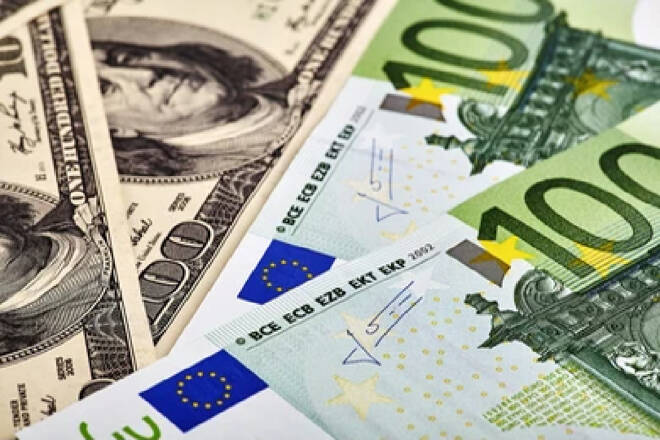Advertisement
Advertisement
EUR/USD Weekly Forecast: Fed Minutes and ECB Minutes and Service Sector Trends in Focus
By:
Investor attention shifts to Eurozone consumer confidence, PMIs, and inflation, driving EUR/USD forecasts amid central bank commentary.
Highlights
- The EUR/USD fell by 0.08% in the week ending February 16, closing the week at $1.07743.
- Hotter-than-expected US inflation figures offset ECB warnings about cutting interest rates too early.
- Central bank commentary, PMIs numbers, inflation, and the Fed and ECB monetary policy meeting minutes warrant investor attention in the week ahead.
Weekly Overview of the EUR/USD in the Week Ending February 16, 2024
In the week ending on February 16, the EUR/USD fell by 0.08% to $1.07743. The EUR/USD rose to a Monday high of $1.08055 before falling to a Wednesday low of $1.06949.
EUR/USD Analysis:
On Wednesday, Eurozone consumer confidence figures for February will draw investor interest. A pickup in consumer confidence could signal a positive outlook for consumer spending. Upward trends in consumer spending may fuel demand-driven inflation and delay ECB plans to cut interest rates.
Economists forecast the Consumer Confidence Index to increase from -16.1 to -15.6.
Preliminary private sector PMIs for France, Germany, and the Eurozone will warrant investor interest on Thursday.
The Services PMIs will likely have more impact, accounting for more than 60% of the Eurozone economy. Significantly, the services sector remains the key contributor to inflation. Beyond the headline numbers, the prices sub-component will be a focal point. A pickup in price pressures would support ECB comments about cutting interest rates too early.
Economists forecast the February Services PMI for the Eurozone to increase from 48.4 to 48.7.
However, finalized Eurozone inflation numbers for January may also influence the ECB rate path. Upward revisions to prelim figures may drive buyer demand for the EUR/USD. According to preliminary numbers, the annual inflation rate declined from 2.9% to 2.8%.
On Friday, the German economy will be under the spotlight again. Finalized Q4 GDP and business sentiment numbers will be in focus. A downward revision to GDP numbers could overshadow a pickup in business sentiment. According to preliminary numbers, the German economy contracted by 0.3% quarter-on-quarter in Q4.
The ECB Calendar
The ECB Monetary Policy Meeting Minutes will draw investor attention on Thursday. A consensus to delay discussions about interest cuts would support the buyer appetite for the EUR. The January ECB Consumer Expectations Survey results could also move the dial on Friday.
However, investors must also monitor ECB commentary. ECB President Christine Lagarde is on the calendar to speak on Friday. Executive Board members Edouard Fernandez-Bollo (Wed/Thurs), Anneli Tuominen (Wed/Thurs), Isabel Schnabel (Fri), and Kerstin af Jochnick (Fri) will also be speaking.
US Economic Calendar
The FOMC Meeting Minutes will influence near-term EUR/USD trends. Recent inflation figures reduced bets on Fed interest rate cuts in March and May. The US dollar will likely show sensitivity to dovish tones as investors raise bets on a June Fed rate cut.
On Thursday, Jobless claims and US private-sector PMIs will influence market projections for the Fed interest rate path. The services sector accounts for more than 70% of the US economy, giving it more weightage. Beyond the headline figure, sub-components, including prices and employment, need consideration. Higher prices and rates of job creation could reduce bets on an H1 2024 Fed rate cut.
Economists forecast the Services PMI to fall from 52.5 to 52.0 in February. Unless there is an unexpected spike in jobless claims, the Services PMI will have more impact.
Economists forecast initial jobless claims to increase from 212k to 217k in the week ending February 17.
Fed Speakers Under the Spotlight
In light of the recent inflation numbers, investors should monitor speeches from FOMC members. FOMC members Michelle Bowman (Wed), Philip Jefferson (Thurs), Lisa Cook (Thurs), Neel Kashkari (Thurs), and Christopher Waller (Thurs) are on the calendar to speak. FOMC voting members Bowman, Cook, Jefferson, and Waller will likely have more influence.
Reactions to the recent economic indicators and views on the timeline for Fed rate cuts would move the dial.
Short-Term Forecast:
The near-term EUR/USD will hinge on the Services PMIs, Eurozone inflation, the ECB and Fed minutes, and central bank commentary. Hawkish Fed commentary and an unexpected pickup in service sector activity could tilt monetary policy divergence toward the US dollar.
EUR/USD Price Action
Daily Chart
The EUR/USD hovered below the 50-day and 200-day EMAs, sending bearish price signals.
A EUR/USD breakout from the $1.07838 resistance level and the 200-day EMA would bring the 50-day EMA into play. A break above the 50-day EMA would support a move toward the $1.09294 resistance level.
Services PMIs, Eurozone inflation, central bank chatter, and monetary policy meeting minutes need consideration.
However, a fall below the $1.07000 handle would bring the $1.06342 support level into view.
The 14-period Daily RSI at 43.81 suggests a EUR/USD drop to the $1.06342 support level before entering oversold territory.
4-Hour Chart
The EUR/USD held above the 50-day EMA while remaining below the 200-day EMA, sending bullish near-term but bearish longer-term price signals.
A EUR/USD move through the $1.07838 resistance level would bring the 200-day EMA and the $1.09294 resistance level into play.
However, a break below the 50-day EMA would support a fall toward the $1.06342 support level.
The 14-period 4-Hourly RSI at 57.09 indicates a EUR/USD move to the $1.09294 resistance level before entering overbought territory.
About the Author
Bob Masonauthor
With over 28 years of experience in the financial industry, Bob has worked with various global rating agencies and multinational banks. Currently he is covering currencies, commodities, alternative asset classes and global equities, focusing mostly on European and Asian markets.
Latest news and analysis
Advertisement
